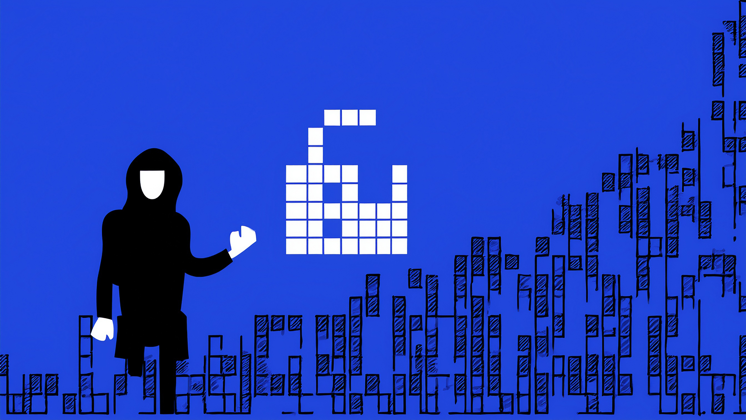Cyberattacks are evolving rapidly and no longer rely on obvious typos or amateurish phishing attempts. Instead, they've embraced artificial intelligence to execute elaborate, highly convincing scams that even seasoned finance professionals can miss.
As a CFO, finance manager, or AP lead, your role requires balancing cash flow, vendor relationships, regulatory compliance, and risk management—all while ensuring the company's financial health stays intact. The last thing you need is an undetectable scam that siphons money out of your accounts.
We've reached a point where AI-driven scams are no longer a hypothetical future threat—they're already costing businesses millions. Below, we break down 13 AI-powered fraud tools in active use against finance teams, with a few practical steps to protect your business.
1. WormGPT
WormGPT is ChatGPT's evil twin—except instead of writing marketing copy, it crafts flawless phishing emails. It learns your company's communication style and makes supposedly urgent wire transfer requests look like they came straight from the CFO.
Communication is polished, professional, and convincing. What's more, WormGPT often evades spam filters because its AI-generated text doesn't use the typical language that sets off phishing triggers.
The result is a perfect storm for business email compromise (BEC) attacks.
Stay protected:
Require dual approvals for high-value transfers.
Train employees to question urgency in financial emails.
Use AI-based email security tools that detect abnormal sender behaviour.
2. Agent Zero
Agent Zero takes BEC scams to the next level with its use of AI to mimic executives and vendors with precision. The autonomous AI system scrapes LinkedIn, company press releases, and public financial statements before incorporating real project names and deals into its emails.
The messages are hyper-personalised, urgent, and business-critical—so finance teams act fast because they believe they're following legitimate directives.
Once a transfer is made, funds disappear into attacker-controlled accounts and are often filtered through multiple layers of laundering.
Stay protected:
Confirm all payment requests via phone or internal chat.
Restrict who can modify vendor banking details in your ERP system.
Audit high-value transactions for peculiarities before finalising.
3. Business Invoice Swapper
This AI-powered scam hijacks invoices before they're paid by subtly altering one thing—the recipient's bank details. Everything else is identical.
Here's how it works:
AI scans email threads and cloud-based invoices for financial transactions.
Machine learning models edit bank details while keeping formatting, logos, and signatures intact.
Automated scripts deploy the altered invoices before finance teams even notice the swap.
This form of fraud is often so subtle that millions of dollars can be lost before anyone detects it.
Stay protected:
Confirm bank detail changes with vendors directly.
Use secure invoice portals instead of email attachments.
Monitor payment records for repeated bank detail modifications.
4. Open-Source Projects Adapted for Criminal Use (SET & GoPhish)
Tools like Social-Engineer Toolkit (SET) and GoPhish were initially devised for use in ethical hacking to help companies test their cybersecurity defences.
Criminals, however, have repurposed these tools for large-scale phishing campaigns. With a few clicks, they create fake login pages that look identical to corporate portals and trick finance teams into handing over credentials.
GoPhish automates spear phishing campaigns, enabling attackers to send hundreds of customised, difficult-to-detect emails at once. Scammers can then refine their tactics by tracking who opens emails and clicks links.
Stay protected:
Run phishing simulations internally to test employee awareness.
Enforce multi-factor authentication (MFA) on all financial platforms.
Restrict administrative access to ensure that one stolen login doesn't grant full system control.
5. FraudGPT and DarkBard
FraudGPT and DarkBard build personalised scam messages that are extremely difficult to distinguish from authentic communication. Both are black-hat derivations of ChatGPT, with the former advertised as an all-in-one solution for cybercriminals.
These generative-AI-based models analyse stolen company data—internal emails, project names, even employee hierarchies—to craft messages tailored for specific finance team members.
They can send top-priority Slack messages, text CFOs whilst impersonating executives, or weave fake supplier requests into email threads.
FraudGPT and DarkBard stay one step ahead of traditional scam filters by mimicking conversation flow and adapting to user behaviour. To evade detection, they also avoid the words and sentence structures most commonly found in spam emails.
Stay protected:
Educate finance teams about AI-driven phishing scams.
Monitor transactions for unusual recipient patterns.
Limit internal data exposure, reducing information accessible to attackers.
6. Morris II Worm
Morris II is an AI-enhanced malware that sneaks into corporate networks and evolves in real-time. It starts by exploiting outdated software and shifts tactics whenever it detects a firewall or security scan.
Once inside the network, it monitors finance workflows, intercepts payment approvals, and reroutes funds virtually undetected. Unlike old-school malware, Morris II adapts its behaviour and renders traditional antivirus solutions almost useless.
Morris II operates by embedding adversarial prompts within inputs processed by GenAI models. When these models process the infected input, they inadvertently create infected outputs that expand the worm's presence across the network (the so-called "zero click" attack method).
Stay protected:
Stringently update software and security patches.
Use behavioural-based threat detection—not just signature-based antivirus.
Segment financial networks so malware can't move laterally.
7. Deepfake Voice Generators
Criminals no longer need stolen emails—they can just call you instead.
Deepfake voice tech clones an executive's speech patterns using a short audio sample, and within a matter of seconds, attackers can fake a phone call and instruct finance teams to process a critical wire transfer.
When an employee hears their CFO's voice telling you to act fast, the instinct is to comply. That's exactly what scammers count on.
Stay protected:
Verify all high-value requests through a second channel.
Educate employees on the dangers of deepfake technology and social engineering tactics.
Limit public recordings of executive voices where possible to reduce cloning risk.
8. AI-Generated Fake Documents
AI can also create invoices, contracts, and compliance documents that look perfect with logos, signatures, and formatting preserved. Some will even mimic the texture of crinkled paper for bank statements and other paper-based documents.
The only discrepancy, of course, is in the payment details.
Fraudsters create fake documents and send them via the proper channels hoping that AP teams are too busy to double-check the details. Because the information looks authentic, it is often weeks or even months before these documents are noticed by staff, vendors, vendors chasing payment.
Stay protected:
Use e-signature platforms that verify authenticity.
Enforce multi-person approval for large or unexpected vendor payments.
Audit financial documents for inconsistencies.
For just $125, wannabe hackers can buy a complete scam toolkit on the dark web complete with:
An anonymity tool
Carding software (to clone credit and debit cards)
Cryptocurrency fraud malware
A keylogger
A ready-made phishing page to mimic trusted brands
A remote access trojan
WIFI hacking software
The availability of these kits means hacking is no longer the domain of tech-savvy criminals—even amateurs can launch successful scams with little experience or know-how. The result is an increase in low-effort, high-reward cybercrime that puts businesses at greater risk.
Stay protected:
Deploy endpoint security tools that detect phishing attempts.
Back up financial data to protect from ransomware or data theft.
Adopt a zero-trust security model that requires verification at every step.
10. Remcos in Excel
Remcos is a remote access trojan (RAT) that hides inside Excel spreadsheets disguised as routine invoices or budget files. The moment an employee enables macros, Remcos installs itself before quietly logging keystrokes and tracking their every move.
Attackers use this access to steal credentials, access financial portals, and initiate unauthorised transactions. Since the Trojan runs in memory and does not install files on disk, staff may not notice the breach until fraudulent payments surface.
Once detected, the attacker may have already siphoned funds, modified vendor records, or set up new payee accounts under fake supplier names.
Stay protected:
Disable macros by default and allow them only for verified sources.
Run Excel attachments in a sandbox before opening them on company systems.
Train staff to recognise suspicious files and avoid enabling content unnecessarily.
11. Agent Tesla Variants
Agent Tesla is a notorious keystroke-logging malware that captures login details the moment they're entered. It first appeared in 2014, and thanks to a combination of affordability and functionality, the malware remains popular with bad actors today.
Once installed, it records every password, bank login, and internal system credential and does not require admin privileges to do so. From there, criminals can approve payments, alter invoices, or redirect funds without raising immediate red flags.
Agent Tesla and its variants represent a highly effective credential-stealing tool that stays hidden until the damage is done. Indeed, organisations typically don't realise they're infected until they see fraudulent transactions or perform a deep security audit.
Stay protected:
Enforce multi-factor authentication (MFA) on all financial platforms.
Monitor for unusual login activity, especially after opening unexpected attachments.
Keep security software updated to detect the latest Agent Tesla variants.
12. Malicious Microsoft Excel Add-ins
Not all Excel add-ins are useful—some are Trojan horses designed to give hackers direct access to finance systems.
The use of malicious .XLL files in phishing attacks have risen by 588%, but many involve RATs (such as this Russian-linked attack) so that fraudsters have constant access to the victim's system.
These tools offer genuine features like advanced data analysis or automated reporting. But in the background, they nefariously log keystrokes, capture screenshots, or enable remote desktop control.
Once installed, attackers can observe financial transactions, swap payment details or approve unauthorised transfers. Since the stated features have actual functionality, employees rarely suspect they've installed malware.
Stay protected:
Require IT approval before the installation of any third-party Excel add-ins.
Periodically audit active add-ins and remove anything unnecessary or unrecognised.
Monitor network traffic for suspicious remote access attempts.
13. Deep-Live-Cam
Deep-Live-Cam is a form of deepfake video that deceives finance teams over video calls. Using AI-generated facial mapping, criminals impersonate executives or vendors in live meetings and make financial requests that appear completely authentic.
Many will request a wire transfer and cite a sensitive deal, legal urgency, or time-sensitive approval to motivate the victim. Employees—who believe the impersonation to be a CEO or other superior—rush to comply without verifying details first.
These scams are difficult to detect. Subtle anomalies such as a lip sync delay, audio artefacts, or inconsistent lighting and shadows could be the only clues that the person on the screen is an impostor.
In 2024, a finance worker at a multinational firm in Hong Kong transferred $25 million to fraudsters after they impersonated the company's CFO with deepfake video technology.
Stay protected:
Verify high-value payment requests via a secondary method such as a phone call or face-to-face meeting if possible.
Educate employees on deepfake technology and the risks of AI-generated impersonations.
Implement call back procedures to verify payee and bank account details.
Final Thoughts
AI has undeniably transformed business operations, but it has also empowered cybercriminals to launch increasingly persuasive and harmful attacks.
From invoice tampering to deepfake impersonations, these 13 tools represent some of the most prevalent threats to business bank accounts in 2025.
So how can you protect yourself from AI-powered scams now and into the future?
How Eftsure can help
Cybercriminals are using AI to execute sophisticated fraud schemes, and in a world where impersonation has never been easier (or more profitable), businesses must be able to protect themselves from financial and reputational harm.
Download our Cybersecurity Guide for CFOs 2025 today to learn how to defend your company’s finances and stay competitive.
In the guide, we detail:
The latest AI-driven scams and how they infiltrate your systems.
How organisations can think like a scammer, stress-test their cybersecurity defences and identify vulnerabilities before they pose a threat.
The role of CFOs in championing anti-cybercrime measures, and
What organisations can do to mitigate risks posed by AI, quantum computing and other emerging technologies.







